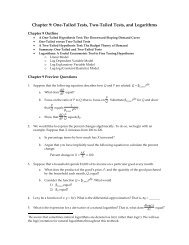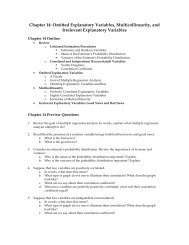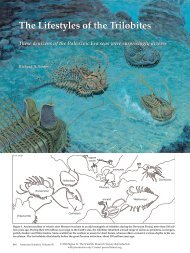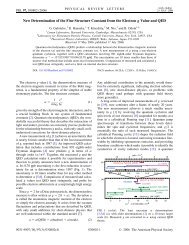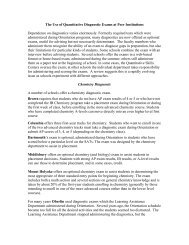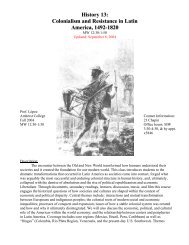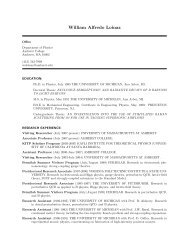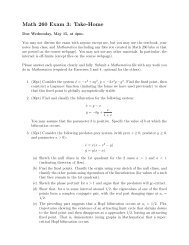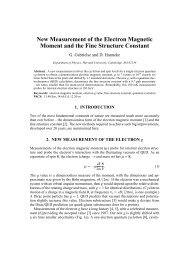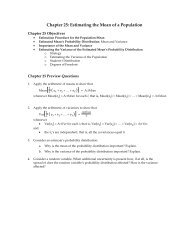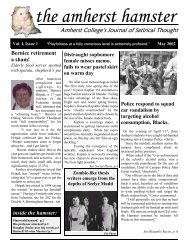sedimentary sedimentary - SEPM
sedimentary sedimentary - SEPM
sedimentary sedimentary - SEPM
You also want an ePaper? Increase the reach of your titles
YUMPU automatically turns print PDFs into web optimized ePapers that Google loves.
Figure 6.<br />
Integrated<br />
chemostratigraphy<br />
and<br />
biostratigraphy<br />
for the<br />
PC-C interval<br />
in the<br />
southern<br />
Great Basin<br />
(data from<br />
Corsetti and<br />
Kaufman,<br />
1994; Corsetti and Hagadorn, 2000 and references therein; this study). The δ 13 C record is most complete at<br />
the Mt. Dunfee section (the most offshore section), where T. pedum occurs in the upper part of the Middle<br />
Deep Spring Formation. The d 13 C record is progressively less complete towards the craton. Stromatolites occur<br />
in the White-Inyo succession in association with the δ 13 C nadir.<br />
gional correlations. The Neoproterozoic-<br />
Cambrian δ 13 C record has been relatively<br />
well characterized and includes many positive<br />
and negative excursions (e.g., Magaritz<br />
et al., 1991; Brasier et al., 1994, 1996;<br />
Strauss et al., 1992; Corsetti and Kaufman,<br />
1994; Shields, 1999; Corsetti et al., 2000;<br />
Montanez et al., 2000) reflecting secular<br />
variation and recognizable globally.<br />
Although most δ 13 C data are recovered from<br />
carbonate dominated successions, it is possible<br />
to analyze organic-rich siliciclastic successions<br />
for δ 13 C org. To be effective, this procedure<br />
requires that the analyzed section did<br />
not experience significant heating, and that<br />
rules out many sections from serious consideration<br />
(e.g., Strauss et al., 1992). Thus,<br />
robust δ 13 C data from siliciclastic-dominated<br />
sections have remained elusive. A carbon<br />
isotope reference curve does not exist for the<br />
PC-C interval, but broadly similar<br />
chemostratigraphic patterns exist among<br />
many PC-C sections (Shields, 1999).<br />
Ignoring low amplitude variations, the<br />
major δ 13 C trends include: 1, a latest<br />
Neoproterozoic major positive carbon isotope<br />
excursion (slightly older than 548 Ma;<br />
Grotzinger et al., 1995), associated with<br />
Cloudina, simple horizontal trace fossils,<br />
and Ediacaran-type fossils; followed by 2, a<br />
pronounced negative carbon isotope excursion<br />
nearly coincident with the PC- C<br />
boundary, at ca. 543-542 Ma (Bowring et<br />
al., 1993; Grotzinger et al., 1995). The precise<br />
position of the negative excursion with<br />
respect to the paleontologic marker of the<br />
boundary was unclear for a number of<br />
years, although it was commonly assumed<br />
that the negative excursion coincided with<br />
the boundary horizon. Corsetti and<br />
Hagadorn (2000) demonstrated that T.<br />
pedum does in fact occur within one negative-<br />
δ 13 C shift of the boundary horizon in<br />
The Sedimentary Record<br />
the Death Valley succession, and this potentially<br />
resolves the question.<br />
The relative synchronicity of the first<br />
appearance of T. pedum and the negative<br />
δ 13 C excursion in the southern Great Basin<br />
can be further tested by comparing samples<br />
from the thinner Death Valley succession to<br />
samples from the much thicker, carbonaterich<br />
White-Inyo succession. High-resolution<br />
sampling for carbon isotope<br />
chemostratigraphy was conducted though<br />
the Deep Spring Formation at multiple sections<br />
across the basin, in concert with biostratigraphic<br />
sampling (Fig. 6). Most of the<br />
Lower Deep Spring Formation, where<br />
Cloudina is present, shows a positive isotopic<br />
excursion (to ~+4‰ PDB). The<br />
excursion is progressively omitted in the<br />
onshore direction, and reaches only ~+2‰<br />
in more onshore sections. A negative excursion,<br />
commonly down to ~-5‰, is recorded<br />
from the top of the Lower Member through<br />
the middle of the Middle Member.<br />
Cloudina also occurs in this interval. The<br />
negative excursion is most pronounced in<br />
offshore sections, where isotopic compositions<br />
plummet to ~-7‰. Curiously, the isotopic<br />
nadir is associated with unusually<br />
abundant stromatolite and thrombolite<br />
development (Oliver and Rowland, 2002).<br />
At Mt. Dunfee, which represents the most<br />
offshore section, δ 13 C values rise to near<br />
0‰, then return to mildly negative values<br />
beneath the Middle-Upper Deep Spring<br />
contact. This excursion is missing from the<br />
other, less complete sections in the onshore<br />
direction. T. pedum occurs in association<br />
with this return to negative δ 13 C values. The<br />
Upper Deep Spring Formation records a<br />
positive excursion to ~+2‰. Thus, the presence<br />
of T. pedum in association with the<br />
negative excursion is verified in the White-<br />
Inyo succession, and it provides a global tiepoint<br />
useful for correlations between siliciclastic-dominated<br />
sections and carbonatedominated<br />
sections.<br />
In addition to providing a tool for<br />
chronostratigraphic work, secular variation<br />
in the δ 13 C record can be used to address<br />
issues of basin scale. For example, if we use<br />
the δ 13 C record as a chronostratigraphic<br />
tool, there is a progressive omission of the<br />
δ 13 C record in the onshore direction. The<br />
most complete isotopic and stratigraphic<br />
records are present in the most offshore sections.<br />
This trend is not unexpected.<br />
However, previously it was not possible to<br />
determine the magnitude of stratal omission<br />
using available lithostratigraphic or biostratigraphic<br />
information.<br />
GLOBAL IMPLICATIONS<br />
Integrated biostratigraphic and chemostratigraphic<br />
information from the southern<br />
Great Basin demonstrate that the first<br />
occurrence of T. pedum, the trace fossil used<br />
to correlate the PC-C boundary, co-occurs<br />
with the ubiquitous negative carbon isotope<br />
excursion recorded in carbonate-dominated<br />
successions around the world. It is beyond<br />
the scope of this paper to correlate between<br />
all the carbonate- and siliciclastic-dominated<br />
section because endemism, hiatuses, and<br />
diagenesis complicate the global picture.<br />
Using the trace fossil and chemostratigraphic<br />
records from the Great Basin as a bridge,<br />
however, it appears that the first occurrence<br />
of small shelly fossils was relatively synchronous<br />
with the first appearance of T. pedum.<br />
If we ignore potential facies control on the<br />
first appearance of T. pedum in the Mt.<br />
Dunfee section, it could be argued that<br />
small shelly fossils just barely predate T.<br />
pedum because the first small shelly fossils<br />
appear in association with relatively negative<br />
δ 13 C values (Knoll et al., 1995). Given the<br />
relatively small amount of stratigraphic<br />
uncertainty, the debate regarding the choice<br />
of trace fossils vs. small shelly fossils as the<br />
stratotype marker is, in our view, rendered<br />
moot. The PC-C transition is well calibrated<br />
(Bowring et al., 1993; Grotzinger et al.,<br />
1995), and the duration of the negative<br />
excursion is constrained to less than one<br />
million years. This implies that phosphatic<br />
biomineralization and vertically-oriented<br />
burrowing developed quickly and nearly<br />
synchronously (probably in less than one<br />
million years). Interestingly, the δ 13 C and<br />
trace fossil biostratigraphic records from the<br />
Mt. Dunfee area closely match the hypothetical,<br />
composite reference section proposed<br />
by Shields (1999).<br />
May 2003 | 7




